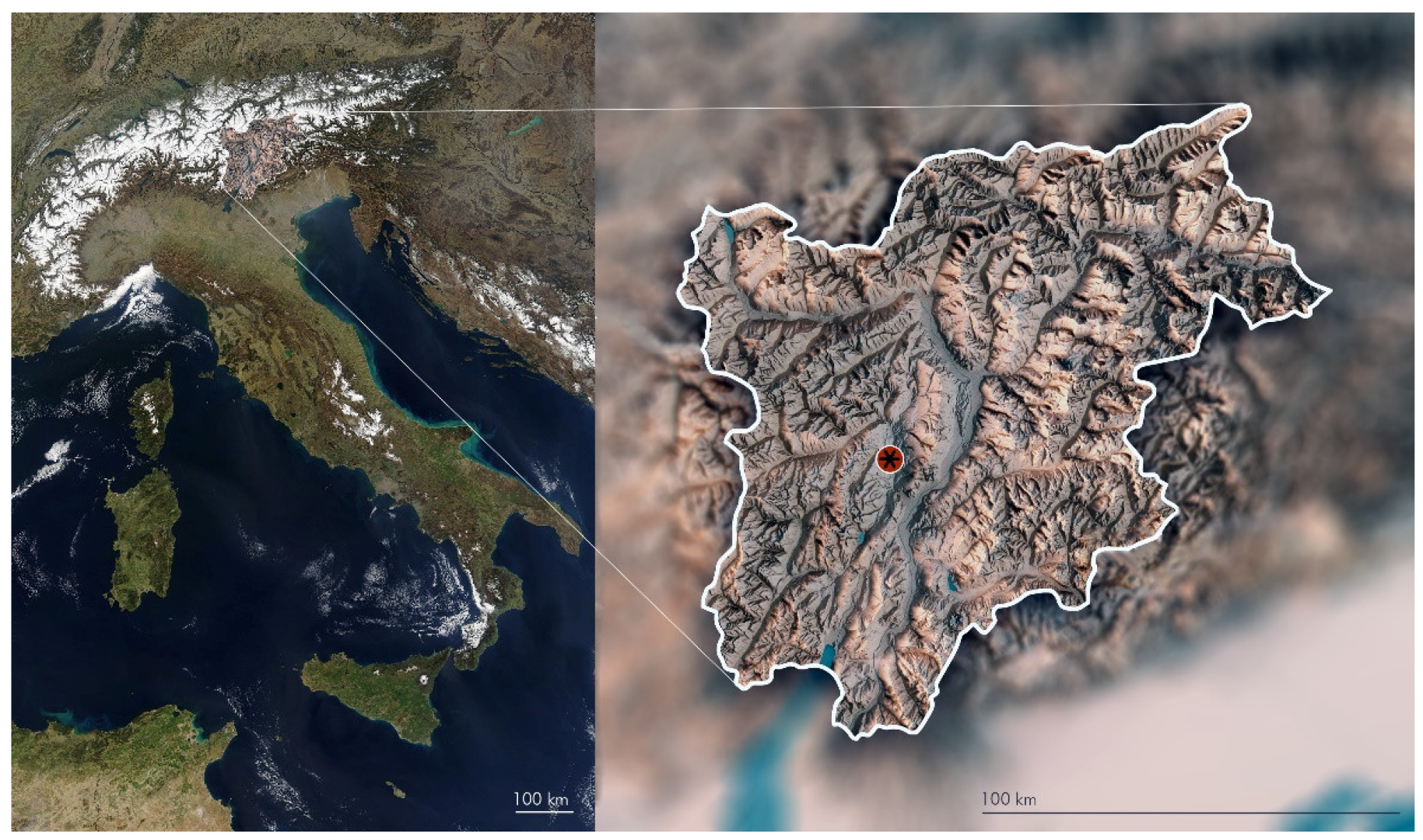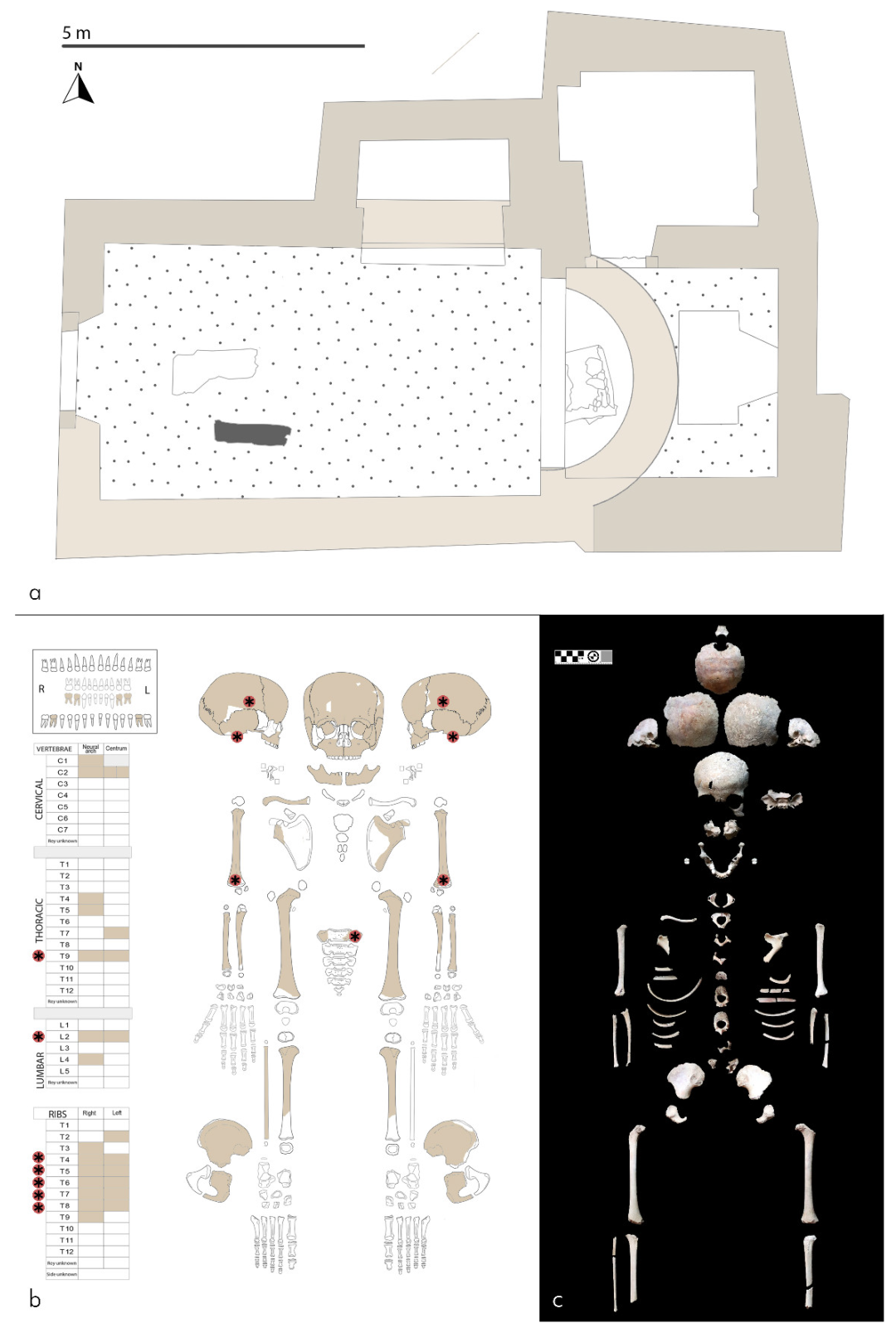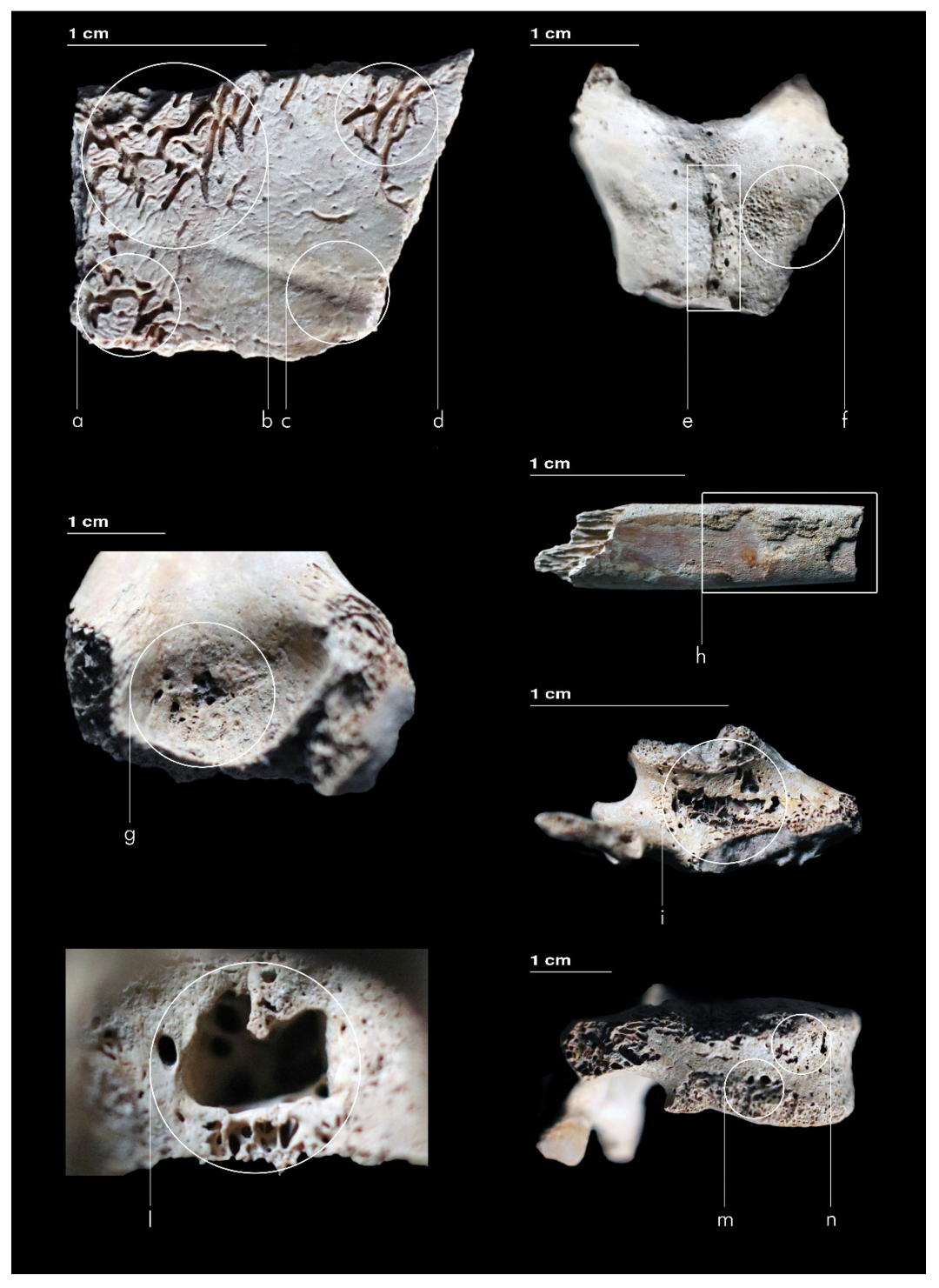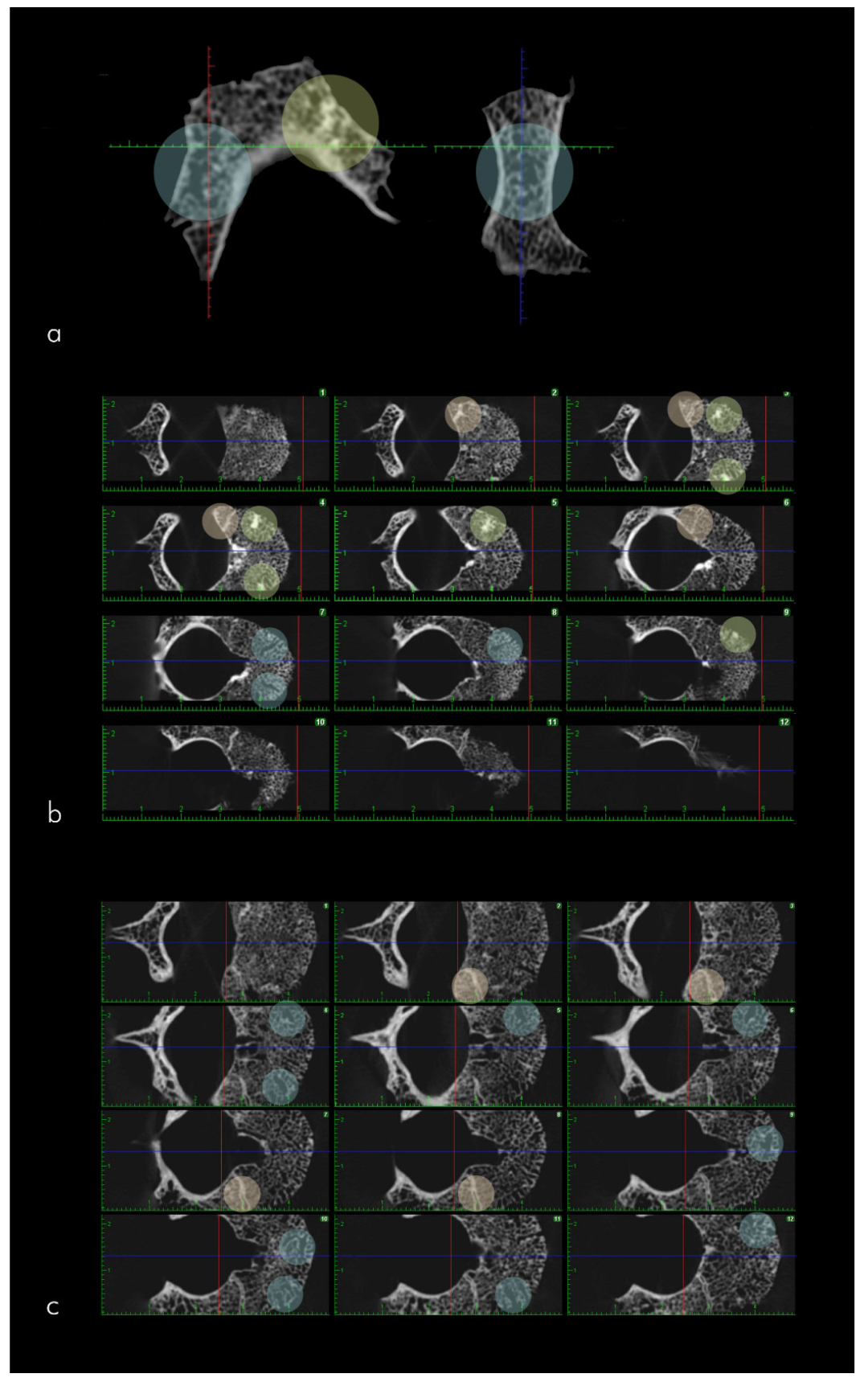Osteological Evidence of Possible Tuberculosis from the Early Medieval Age (6th–11th Century), Northern Italy
Abstract
1. Introduction
1.1. Tuberculosis in Non-Adults
1.2. Historical and Archaeological Background
2. Materials and Methods
Ethical Statement
3. Results
4. Discussion
5. Conclusions
Author Contributions
Funding
Institutional Review Board Statement
Informed Consent Statement
Data Availability Statement
Acknowledgments
Conflicts of Interest
References
- Boddy, A.M.; Fortunato, A.; Wilson Sayres, M.; Aktipis, A. Fetal microchimerism and maternal health: A review and evolutionary analysis of cooperation and conflict beyond the womb. Bioessays 2015, 37, 1106–1118. [Google Scholar] [CrossRef]
- Lapaire, O.; Hösli, I.; Zanetti-Daellenbach, R.; Huang, D.; Jaeggi, C.; Gatfield-Mergenthaler, S.; Hahn, S.; Holzgreve, W. Impact of fetal-maternal microchimerism on women’s health—A review. J. Matern. Neonatal Med. 2007, 20, 1–5. [Google Scholar] [CrossRef]
- Veena, S.R.; Gale, C.R.; Krishnaveni, G.V.; Kehoe, S.H.; Srinivasan, K.; Fall, C.H.D. Association between maternal nutritional status in pregnancy and offspring cognitive function during childhood and adolescence; a systematic review. BMC Pregnancy Childbirth 2016, 16, 1–24. [Google Scholar] [CrossRef]
- Wei, S.Q.; Qi, H.P.; Luo, Z.C.; Fraser, W.D. Maternal vitamin D status and adverse pregnancy outcomes: A systematic review and meta-analysis. J. Matern. Neonatal Med. 2013, 26, 889–899. [Google Scholar] [CrossRef]
- Badgett, T.; Feingold, M. Total parenteral nutrition in pregnancy: Case review and guidelines for calculating requirements. J. Matern. Neonatal Med. 1997, 6, 215–217. [Google Scholar] [CrossRef]
- Lee, R.V.; Rodgers, B.D.; Young, C.; Eddy, E.; Cardinal, J. Total parenteral nutrition during pregnancy. Obstet. Gynecol. 1986, 68, 563–571. Available online: https://pubmed.ncbi.nlm.nih.gov/3092156/ (accessed on 20 May 2023).
- Than, N.G.; Hahn, S.; Rossi, S.W.; Szekeres-Bartho, J. Fetal-maternal immune interactions in pregnancy. Front. Immunol. 2019, 10, 2729. [Google Scholar] [CrossRef] [PubMed]
- Trowsdale, J.; Betz, A.G. Mother’s little helpers: Mechanisms of maternal-fetal tolerance. Nat. Immunol. 2006, 7, 241–246. Available online: https://pubmed.ncbi.nlm.nih.gov/16482172/ (accessed on 20 May 2023).
- Gowland, R.; Halcrow, C. The Mother Infant Nexus in Anthropology: Small Beginnings, Significant Outcomes; Springer Nature Switzerland AG: Cham, Switzerland, 2020. [Google Scholar] [CrossRef]
- Buikstra, J. Ortner’s Identification of Pathological Conditions in Human Skeletal Remains; Academic Press: Cambridge, MA, USA, 2019. [Google Scholar] [CrossRef]
- Brickley, M.; Ives, R.; Mays, S.G.M. The Bioarchaeology of Metabolic Bone Disease, 2nd ed.; Academic Press: Cambridge, MA, USA, 2020. [Google Scholar]
- Lewis, M.E. Fetal Paleopathology: An Impossible Discipline. In The Anthropology of the Fetus: Biology, Culture, and Society; Han, S., Betsinger, T.K., Scott, B.A., Eds.; Berghahn Books: New York, NY, USA, 2018; pp. 112–131. [Google Scholar]
- Ubelaker, D.H.; De La Paz, J.S. Skeletal indicators of pregnancy and parturition: A historical review: Skeletal indicators of pregnancy and parturition. J. Forensic. Sci. 2012, 57, 866–872. [Google Scholar] [CrossRef] [PubMed]
- Väre, T.; Lipkin, S.; Kallio-Seppä, T.; Tranberg, A.; Junno, J.A. Possible case of partial postmortem fetal extrusion: Preliminary observations on the mummified remains of a turn-of-the-19th-century noblewoman in Finland. Int. J. Osteoarchaeol. 2021, 31, 1280–1284. [Google Scholar] [CrossRef]
- Basu Roy, R.; Whittaker, E.; Seddon, J.A.; Kampmann, B. Tuberculosis susceptibility and protection in children. Lancet Infect. Dis. 2019, 19, e96–e108. [Google Scholar] [CrossRef]
- Larentis, O.; Tonina, E. A possible case of tuberculosis from a medieval site in northeast Italy. The infant of the Immacolata and San Zenone church, Tassullo, Trentino. Med. Hist. 2021, 5, e2021021. [Google Scholar]
- Larentis, O.; Tonina, E.; Tesi, C.; Rossetti, C.; Gorini, I.; Ciliberti, R.; Licata, M. A probable case of subligamentous tuberculous spondylitis: The concealed body of the Late Modern Period (early 16th century to early 20th century), Franciscan crypt of St. Anthony and St. Eusebius church, Lombardy, Italy. Int. J. Osteoarchaeol. 2020, 30, 180–196. [Google Scholar] [CrossRef]
- Churchyard, G.; Kim, P.; Shah, N.S.; Rustomjee, R.; Gandhi, N.; Mathema, B.; Dowdy, D.; Kasmar, A.; Cardenas, V. What we know about tuberculosis transmission: An overview. J. Infect. Dis. 2017, 216, 629–635. [Google Scholar] [CrossRef] [PubMed]
- GTR (2022) Global Tuberculosis Report 2022; World Health Organization: Geneva, Switzerland, 2022; Available online: https://www.who.int/teams/global-tuberculosis-programme/tb-reports/global-tuberculosis-report-2022 (accessed on 20 May 2023).
- Mariotti, V.; Zuppello, M.; Pedrosi, M.E.; Bettuzzi, M.; Brancaccio, R.; Peccenini, E.; Morigi, M.P.; Belcastro, M.G. Skeletal evidence of tuberculosis in a modern identified human skeletal collection (Certosa cemetery, Bologna, Italy): Skeletal Evidence of Tuberculosis. Am. J. Phys. Anthropol. 2015, 157, 389–401. [Google Scholar] [CrossRef] [PubMed]
- Garg, R.K.; Somvanshi, D.S. Spinal tuberculosis: A review. J. Spinal Cord Med. 2011, 34, 440–454. [Google Scholar] [CrossRef] [PubMed]
- Pálfi, G.; Dutour, O.; Deak, J.; Hutas, I. Tuberculosis Past and Present; Golden Book: Budapest, Hungary, 1999. [Google Scholar]
- Ortner, D.J. Identification of Pathological Conditions in Human Skeletal Remains, 2nd ed.; Academic Press: Cambridge, MA, USA, 2003. [Google Scholar]
- Roberts, C.A.; Buikstra, J.E. The Bioarchaeology of Tuberculosis: A Global View on a Reemerging Disease, 1st ed.; University Press of Florida: Gainesville, FL, USA, 2003. [Google Scholar]
- Roberts, C.A. Re-Emerging Infections: Developments in Bioarchaeological Contributions to Understanding Tuberculosis Today. In A Companion to Paleopathology, 2nd ed.; Grauer, A.L., Ed.; Blackwell: Boston, MA, USA, 2016; pp. 434–457. [Google Scholar]
- Roberts, C.A.; Pfister, L.A.; Mays, S. Was tuberculosis present in Homo erectus in Turkey? Am. J. Phys. Anthropol. 2009, 139, 442–444. [Google Scholar] [CrossRef]
- Donoghue, H.D.; Spigelman, M.; Zias, J.; Gernaey-Child, A.M.; Minnikin, D.E. Mycobacterium tuberculosis complex DNA in calcified pleura from remains 1400 years old. Lett. Appl. Microbiol. 1998, 27, 265–269. [Google Scholar] [CrossRef]
- Resnick, D.; Niwayama, G. Enostosis, Hyperostosis and Periostitis. In Bone and Joint Imaging, 3rd ed.; Resnick, D., Ed.; WB Saunders Company: Philadelphia, PA, USA, 2004; pp. 4396–4466. [Google Scholar]
- Resnick, D.; Niwayama, G. Osteomyelitis, Septic Arthritis, and Soft Tissue Infection: Organisms. In Bone and Joint Imaging, 3rd ed.; Resnick, D., Ed.; WB Saunders Company: Philadelphia, PA, USA, 2004; pp. 2467–2474. [Google Scholar]
- Resnick, D.; Niwayama, G. Osteomyelitis, Septic Arthritis, and Soft Tissue Infection: Axial Skeleton. In Bone and Joint Imaging, 3rd ed.; Resnick, D., Ed.; WB Saunders Company: Philadelphia, PA, USA, 2004; pp. 2419–2447. [Google Scholar]
- Roberts, C.; Lucy, D.; Manchester, K. Inflammatory lesions of ribs: An analysis of the Terry Collection. Am. J. Phys. Anthropol. 1994, 95, 169–182. [Google Scholar] [CrossRef]
- Sparacello, V.S.; Roberts, C.A.; Canci, A.; Moggi-Cecchi, J.; Marchi, D. Insights on the paleoepidemiology of ancient tuberculosis from the structural analysis of postcranial remains from the Ligurian Neolithic (northwestern Italy). Int. J. Paleopathol. 2016, 15, 50–64. [Google Scholar] [CrossRef]
- Sparacello, V.S.; Roberts, C.A.; Kerudin, A.; Müller, R. A 6500-year-old Middle Neolithic child from Pollera Cave (Liguria, Italy) with probable multifocal osteoarticular tuberculosis. Int. J. Paleopathol. 2017, 17, 67–74. [Google Scholar] [CrossRef]
- Formicola, V.; Milanesi, Q.; Scarsini, C. Evidence of spinal tuberculosis at the beginning of the fourth millennium BC from Arene Candide cave (Liguria, Italy). Am. J. Phys. Anthropol. 1987, 72, 1–6. [Google Scholar] [CrossRef]
- Mazzoleni, P.; Pisu, N.; Asolati, M. L’Immacolata e San Zenone a Sanzenone di Tassullo: Storia, Archeologia, Architettura e Arte di Una Chiesa Della Valle di Non; Comune di Tassullo: Tassullo, Italy, 2015. [Google Scholar]
- Schaefer, M.; Black, S.; Scheuer, L. Juvenile Osteology; Academic Press: Burlington, MA, USA, 2009. [Google Scholar]
- Liversidge, H.M.; Dean, M.C.; Molleson, T.I. Increasing human tooth length between birth and 5.4 years. Am. J. Phys. Anthropol. 1993, 90, 307–313. [Google Scholar] [CrossRef]
- Liversidge, H.M.; Herdeg, B.; Rösing, F.W. Dental age estimation of non-adults. A review of methods and principles. In Dental Anthropology, 1st ed.; Alt, K.W., Rösing, F.W., Teschler-Nicola, M., Eds.; Springer: Vienna, Austria, 1998; pp. 419–442. [Google Scholar]
- AlQahtani, S.J.; Hector, M.P.; Liversidge, H.M. The London atlas of human tooth development and eruption. Am. J. Phys. Anthropol. 2010, 142, 481–490. [Google Scholar] [CrossRef] [PubMed]
- Elamin, F.; Liversidge, H.M. Malnutrition has no effect on the timing of human tooth formation. PLoS ONE 2013, 8, e72274. [Google Scholar] [CrossRef]
- Fusco, R.; Larentis, O.; Cermesoni, B.; Ravagnan, A.; Tesi, C. The “mummy of Erba”: A study proposal for the analysis of a mummified egyptian specimen. Med. Hist. 2018, 2, 163–165. [Google Scholar]
- Buikstra, J.E.; Ubelaker, D.H. Standards for Data Collection from Human Skeletal Remains. (Report Number 44), 1st ed.; Archaeological Survey; Arkansas Archaeological Survey: Fayetteville, NC, USA, 1994. [Google Scholar]
- Squires, K.; Roberts, C.A.; Márquez-Grant, N. Ethical considerations and publishing in human bioarcheology. Am. J. Biol. Anthropol. 2022, 177, 615–619. [Google Scholar] [CrossRef] [PubMed]
- Daoud, A. Bone and joint tuberculosis in the child. In Tuberculosis of the Bones and Joints; Martini, M., Ed.; Springer: New York, NY, USA, 1988; pp. 34–38. [Google Scholar]
- Dawson, H.; Robson Brown, K. Childhood tuberculosis: A probable case from late mediaeval Somerset, England. Int. J. Paleopat. 2012, 2, 31–35. [Google Scholar] [CrossRef]
- Baker, J.O.; Chamel, B.; Dutour, O. New Paleopathological Evidence of Tuberculosis in Child Skeletal Remains from Tell Aswad (8730–8290 cal. BC, southern Syria). Paléorient 2021, 47, 97–108. [Google Scholar] [CrossRef]
- Bennike, P. Fact or myths? A re-evaluation of cases of diagnosed tuberculosis in the past in Denmark. In Tuberculosis: Past and Present; Pálfi, G., Dutour, O., Deák, J., Hutás, I., Eds.; Golden Book Publisher Ltd.: Szeged, Hungary, 1999; pp. 511–518. [Google Scholar]
- Buikstra, J.E. Paleoepidemiology of tuberculosis in the Americas. In Tuberculosis: Past and Present; Pálfi, G., Dutour, O., Deák, J., Hutás, I., Eds.; Golden Book Publisher Ltd.: Szeged, Hungary, 1999; pp. 479–494. [Google Scholar]
- Dabernat, H.; Crubézy, É. Multiple bone tuberculosis in a child from predynastic Upper Egypt (3200 BC). Int. J. Osteoarchaeol. 2010, 20, 719–730. [Google Scholar] [CrossRef]
- Jankauskas, R. Tuberculosis in Lithuania: Palaeopathological and historical correlations. In Tuberculosis: Past and Present; Pálfi, G., Dutour, O., Deák, J., Hutás, I., Eds.; Golden Book Publisher Ltd.: Szeged, Hungary, 1999; pp. 551–558. [Google Scholar]
- Hlavenková, L.; Teasdale, M.D.; Gábor, O.; Nagy, G.; Beňuš, R.; Marcsik, A.; Pinhasi, R.; Hajdu, T. Childhood bone tuberculosis from Roman Pécs, Hungary. HOMO-J. Comp. Hum. Biol. 2015, 66, 27–37. [Google Scholar] [CrossRef]
- Schultz, M. The role of tuberculosis in infancy and childhood in prehistoric and historicpopulations. In Tuberculosis: Past and Present; Pálfi, G., Dutour, O., Deák, J., Hutás, I., Eds.; Golden Book Publisher Ltd.: Szeged, Hungary, 1999; pp. 503–507. [Google Scholar]
- Lewis, M.E. Endocranial lesions in non-adult skeletons: Understanding their aetiology. Int. J. Osteoarchaeol. 2004, 14, 82–97. [Google Scholar] [CrossRef]
- Hershkovitz, I.; Greenwald, C.M.; Latimer, B.; Jellema, L.M.; Wish-Baratz, S.; Eshed, V.; Dotour, O.; Rothschild, B.M. Serpens endocrania symmetrica (SES): A new term and a possible clue for identifying intrathoracic disease in skeletal populations. Am. J. Phys. Anthropol. 2002, 118, 201–216. [Google Scholar] [CrossRef]
- Lovejoy, C.O.; Meindl, R.S.; Pryzbeck, T.R.; Barton, T.S.; Heiple, K.G.; Kotting, D. Paleodemography of the libben site, Ottawa county, Ohio. Science 1977, 198, 291–293. [Google Scholar] [CrossRef]
- Mensforth, R.P.; Lovejoy, C.O.; Lallo, J.W.; Armelagos, G.J. The role of constitutional factors, diet, and infectious disease in the etiology of porotic hyperostosis and periosteal reactions in prehistoric infants and children. Med. Anthropol. 1978, 2, 1–59. [Google Scholar] [CrossRef]
- Aminov, R.I. A brief history of the antibiotic era: Lessons learned and challenges for the future. Front. Microbiol. 2010, 1, 134. [Google Scholar] [CrossRef] [PubMed]
- Spekker, O.; Schultz, M.; Paja, L.; Váradi, O.A.; Molnár, E.; Pálfi, G.; Hunt, D. Tracking down the White Plague. Chapter two: The role of endocranial abnormal blood vessel impressions and periosteal appositions in the paleopathological diagnosis of tuberculous meningitis. PLoS ONE 2020, 15, e0238444. [Google Scholar] [CrossRef]
- Stans, A.A.; Lawrence, J.T.R. Dislocations of the elbows, medial Epicondylar Humerus fractures. In Rockwood and Wilkins’ Fractures in Children, 8th ed.; Flynn, J.M., Skaggs, D.L., Waters, P.M., Eds.; Wolters Kluwer Health/Lippincott Williams & Wilkins: Philadelphia, PA, USA, 2015; pp. 625–698. [Google Scholar]
- Lepore, N.; Cashin, M.; Bartley, D.; Ardelean, D.S. Atypical monoarthritis presentation in children with oligoarticular juvenile idiopathic arthritis: A case series. Pediatr. Rheumatol. 2017, 15, 2. [Google Scholar] [CrossRef]
- Mo, J.; Pan, J.; Liu, Y.; Feng, W.; Li, B.; Luo, K.; Mo, W.; Lin, H.; Liao, S. Bilateral synovial chondromatosis of the elbow in an adolescent: A case report and literature review. BMC Musculoskelet. Disord. 2020, 21, 377. [Google Scholar] [CrossRef] [PubMed]
- Hyvönen, H.; Korhonen, L.; Hannonen, J.; Serlo, W.; Sinikumpu, J.J. Recent trends in children’s elbow dislocation with or without a concomitant fracture. BMC Musculoskelet. Disord. 2019, 20, 294. [Google Scholar] [CrossRef] [PubMed]
- Agarwal, A.; Mumtaz, I.; Kumar, P.; Khan, S.; Qureshi, N.A. Tuberculosis of the elbow joint in children: A review of ten patients who were managed nonoperatively. J. Bone Jt. Surg. Am. 2010, 92, 436–441. [Google Scholar] [CrossRef]
- Gailson, T.; Arpitha, K.; Bhatia, A.; Saini, A.G. Tuberculosis of the humerus: An uncommon site in children. BMJ Case Rep. 2022, 15, e249268. [Google Scholar] [CrossRef]
- Kelley, M.A.; Micozzi, M.S. Rib lesions in chronic pulmonary tuberculosis. Am. J. Phys. Anthropol. 1984, 65, 381–386. [Google Scholar] [CrossRef] [PubMed]
- Santos, A.L.; Roberts, C.A. Anatomy of a serial killer: Differential diagnosis of tuberculosis based on rib lesions of adult individuals from the Coimbra Identified Skeletal Collection, Portugal. Am. J. Phys. Anthropol. 2006, 130, 38–49. [Google Scholar] [CrossRef] [PubMed]
- Matos, V.; Santos, A.L. On the trail of pulmonary tuberculosis based on rib lesions: Results from the Human Identified Skeletal Collection from the Museu Bocage (Lisbon, Portugal). Am. J. Phys. Anthropol. 2006, 130, 190–200. [Google Scholar] [CrossRef] [PubMed]
- Davies-Barrett, A.M.; Antoine, D.; Roberts, C.A. Inflammatory periosteal reaction on ribs associated with lower respiratory tract disease: A method for recording prevalence from sites with differing preservation. Am. J. Phys. Anthropol. 2019, 168, 530–542. [Google Scholar] [CrossRef]
- Waldron, T. Palaeopathology; Cambridge University Press: Cambridge, UK, 2009. [Google Scholar]
- Weston, D.A. Nonspecific infection in palaeopathology: Interpreting periosteal reactions. In A Companion to Palaeopathology, 1st ed.; Grauer, A.L., Ed.; Blackwell Publishing Ltd.: Chichester, UK, 2012; pp. 492–512. [Google Scholar]
- Wang, J.; Li, D.; Yang, R.; Tang, X.; Yan, T.; Guo, W. Epidemiological characteristics of 1385 primary sacral tumors in one institution in China. World J. Surg. Oncol. 2020, 18, 297. [Google Scholar] [CrossRef]
- Lam, C.H.; Nagib, M.G. Nonteratomatous tumors in the pediatric sacral region. Spine 2002, 27, E284–E287. [Google Scholar] [CrossRef]
- Raymond, F.; Levard, G.; Bataille, B. Sacral bone tuberculosis in a 6 year-old child. Arch. Pediatr. 1994, 1, 489–492. [Google Scholar]
- Shiran, S.I.; Shabtai, L.; Ben-Sira, L.; Ovadia, D.; Wientroub, S. T1-weighted MR imaging of bone marrow pattern in children with adolescent idiopathic scoliosis: A preliminary study. J. Child. Orthop. 2018, 12, 181–186. [Google Scholar] [CrossRef] [PubMed]
- Tyagi, R. Spinal infections in children: A review. J. Orthop. 2016, 13, 254–258. [Google Scholar] [CrossRef] [PubMed]
- Kumar, R. Spinal tuberculosis: With reference to the children of northern India. Childs Nerv. Syst. 2005, 21, 19–26. [Google Scholar] [CrossRef] [PubMed]
- Spekker, O.; Hunt, D.R.; Váradi, O.A.; Berthon, W.; Molnár, E.; Pálfi, G. Rare manifestations of spinal tuberculosis in the Robert J. Terry Anatomical Skeletal Collection (National Museum of Natural History, Smithsonian Institution, Washington, DC, USA). Int. J. Osteoarchaeol. 2018, 28, 343–353. [Google Scholar] [CrossRef]
- Schirmer, P.; Renault, C.A.; Holodniy, M. Is spinal tuberculosis contagious? Int. J. Infect. Dis. 2010, 14, e659–e666. [Google Scholar] [CrossRef] [PubMed]
- Holloway, K.L.; Link, K.; Rühli, F.; Henneberg, M. Skeletal lesions in human tuberculosis may sometimes heal: An aid to palaeopathological diagnoses. PLoS ONE 2013, 8, e62798. [Google Scholar] [CrossRef]
- Hoskyns, W. Paediatric tuberculosis. Postgrad. Med. J. 2003, 79, 272–278. [Google Scholar] [CrossRef]
- Sun, J.C.; Ugolini, S.; Vivier, E. Immunological memory within the innate immune system. EMBO J. 2014, 33, 1295–1303. [Google Scholar] [CrossRef]
- Newburg, D.S.; Walker, W.A. Protection of the neonate by the innate immune system of developing gut and of human milk. Pediatr. Res. 2007, 61, 2–8. [Google Scholar] [CrossRef]
- Larentis, O.; Licata, M.; Tonina, E.; Pangrazzi, C. Probable micronutrient deficiency diseases in a rural community. The nonadults of Mary’s Nativity church, 16th century, Trentino Alto-Adige, Italy. J. Archaeol. Sci. Rep. 2022, 47, 103774. [Google Scholar] [CrossRef]
- Morel, M.F. La mort d’un bébé au fil de l’histoire. Spirale 2004, 31, 15–34. [Google Scholar] [CrossRef]
- Lewis, M.E.; Gowland, R. Brief and precarious lives: Infant mortality in contrasting sites from medieval and post-medieval England (AD 850-1859). Am. J. Phys. Anthropol. 2007, 134, 117–129. [Google Scholar] [CrossRef]
- Larentis, O.; Tonina, E.; Iorio, S.; Gorini, I.; Licata, M. Osteological evidence of metabolic diseases from a post medieval North Italy archaeological site. J. Matern. Fetal Neonatal Med. 2020, 33, 2735–2742. [Google Scholar] [CrossRef] [PubMed]
- Larentis, O. Sepolture Infantili Bassomedievali. Il Caso Della Chiesa Della Natività della Vergine Maria di Segno (Taio-TN). In NEALM Necropoli Altomedievali e Medievali; Possenti, E., Ed.; Editreg: Trieste, Italy, 2017; pp. 117–140. [Google Scholar]
- Giuffra, V.; Fornaciari, G. Breastfeeding and weaning in renaissance Italy: The Medici children. Breastfeed. Med. 2013, 8, 257–262. Available online: https://pubmed.ncbi.nlm.nih.gov/23259644/ (accessed on 20 May 2023).
- Haas, L. The Renaissance Man and His Children. Childbirth and Early Childhood in Florence, 1300–1600; MacMillan: London, UK, 1998. [Google Scholar]
- Meehan, C.L.; Crittenden, A.N. Childhood: Origins, Evolution, and Implications; University of New Mexico Press: Albuquerque, NM, USA, 2016. [Google Scholar]
- Reissland, N.; Kisilevsky, B.S. Fetal Development: Research on Brain and Behavior, Environmental Influences, and Emerging Technologies; Springer: Basel, Germany, 2016. [Google Scholar]
- Wall-Scheffler, C.M.; Geiger, K.; Steudel-Numbers, K.L. Infant carrying: The role of increased locomotory costs in early tool development. Am. J. Phys. Anthropol. 2007, 133, 841–846. [Google Scholar] [CrossRef]
- Babones, S.J. Income inequality and population health: Correlation and causality. Soc. Sci. Med. 2008, 66, 1614–1626. [Google Scholar] [CrossRef] [PubMed]
- Fornaciari, G.; Ciranni, R.; Busoni, C.A.; Gamba, S.; Benedetti, E.; Mallegni, F.; Nelli, S.; Rollo, F. Santa Zita Di Lucca: Malattie, Ambiente E Società Dallo Studio Di Una Mummia Naturale Del XIII Secolo. In Proceedings of the Congresso Italiano di Anatomia, Istologia e Citologia Patologica, Università di Pisa, Pisa, Italy, 21–24 May 1997. [Google Scholar]
- Lewis, M.E. Urbanisation and Child Health in Medieval and Post-Medieval England; Archaeopress: Oxford, UK, 2002. [Google Scholar]
- Forbes, T.R. Mortality books for 1820 to 1849 from the parish of st. Bride, fleet street, London. J. Hist. Med. Allied. Sci. 1972, 17, 15–29. [Google Scholar] [CrossRef]
- Beaven, P.W. An analysis of tuberculous infection from birth to old age; its relationship to clinical tuberculosis and deaths from tuberculosis. Dis. Chest 1950, 17, 280–292. [Google Scholar] [CrossRef]
- Smith, S.; Jacobs, R.F.; Wilson, C.B. Immunobiology of childhood tuberculosis: A window on the ontogeny of cellular immunity. J. Pediatr. 1997, 131, 16–26. [Google Scholar] [CrossRef]
- Snoddy, A.M.E.; Buckley, H.R.; Elliott, G.E.; Standen, V.G.; Arriaza, B.T.; Halcrow, S.E. Macroscopic features of scurvy in human skeletal remains: A literature synthesis and diagnostic guide. Am. J. Phys. Anthropol. 2018, 167, 876–895. [Google Scholar] [CrossRef]
- Brickley, M.B.; Mays, S.G.M.; Prowse, T.L. Analysis of patterning in the occurrence of skeletal lesions used as indicators of vitamin D deficiency in subadult and adult skeletal remains. Int. J. Paleopathol. 2018, 23, 43–53. [Google Scholar] [CrossRef]
- Brambell, F.W.R. The Transmission of Passive Immunity from Mother to Young; North-Holland Publishing Co.: Amsterdam, The Netherlands, 1970. [Google Scholar]




| Site | Region | Chronology | n ID/Sex | Age |
|---|---|---|---|---|
| Pollera Cave [32,33] | Liguria | C14 date: 5730 ± 3 0 BP; 4624–4455 BCE (2σ) | 1/- | 5 years |
| Arene Candide [34] | Liguria | C14 date: 1st half of 4th millennium BCE | 1/M | 15 years |
| Tassullo [35] | Trentino Alto-Adige | 6th–11th century CE | 1/- | 9 months |
| Parma [20] | Emilia Romagna | 19th–20th century CE | 4/F 4/M | 17–20 years 17–20 years |
| Vertebra | Side Location [42] | Bone Location [42] | Extent of Involvement [42] | Number of Foci [42] | Trait Observed [20] | Size of Lesion [20] |
|---|---|---|---|---|---|---|
| T7 | Lateral R | P/E | <1/3 | 1 | OtF | <3 mm |
| Lateral L | NP | NP | 2 | Er (1) OtF (1) | <3 mm | |
| T9 | Lateral R | P/E | <1/3 | 5 | ER (3) OtF (2) | <3 mm |
| Lateral L | P/E | <1/3 | 3 | ER (3) | <3 mm | |
| L2 | Lateral R | P/E | <1/3 | 4 | ER (2) OtF (2) | <3 mm |
| Lateral L | P/E | <1/3 | 3 | ER (1) OtF (2) | <3 mm |
Disclaimer/Publisher’s Note: The statements, opinions and data contained in all publications are solely those of the individual author(s) and contributor(s) and not of MDPI and/or the editor(s). MDPI and/or the editor(s) disclaim responsibility for any injury to people or property resulting from any ideas, methods, instructions or products referred to in the content. |
© 2023 by the authors. Licensee MDPI, Basel, Switzerland. This article is an open access article distributed under the terms and conditions of the Creative Commons Attribution (CC BY) license (https://creativecommons.org/licenses/by/4.0/).
Share and Cite
Larentis, O.; Pangrazzi, C.; Tonina, E. Osteological Evidence of Possible Tuberculosis from the Early Medieval Age (6th–11th Century), Northern Italy. Heritage 2023, 6, 4886-4900. https://doi.org/10.3390/heritage6070260
Larentis O, Pangrazzi C, Tonina E. Osteological Evidence of Possible Tuberculosis from the Early Medieval Age (6th–11th Century), Northern Italy. Heritage. 2023; 6(7):4886-4900. https://doi.org/10.3390/heritage6070260
Chicago/Turabian StyleLarentis, Omar, Caterina Pangrazzi, and Enrica Tonina. 2023. "Osteological Evidence of Possible Tuberculosis from the Early Medieval Age (6th–11th Century), Northern Italy" Heritage 6, no. 7: 4886-4900. https://doi.org/10.3390/heritage6070260
APA StyleLarentis, O., Pangrazzi, C., & Tonina, E. (2023). Osteological Evidence of Possible Tuberculosis from the Early Medieval Age (6th–11th Century), Northern Italy. Heritage, 6(7), 4886-4900. https://doi.org/10.3390/heritage6070260





